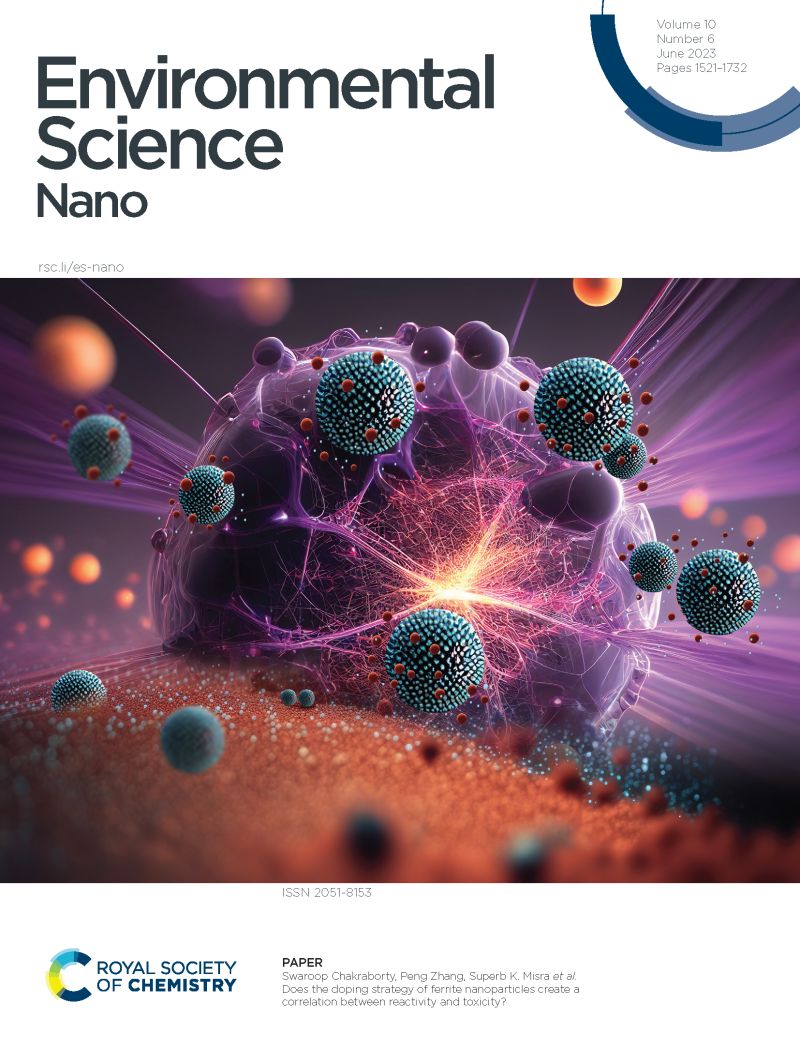The surface charge both influences the penetration and safety of polystyrene nanoparticles despite the protein corona formation
IF 5.8
2区 环境科学与生态学
Q1 CHEMISTRY, MULTIDISCIPLINARY
引用次数: 0
Abstract
Micro- and nano-plastics' (MNPs') environmental persistence generates relevant alarm. This concern is amplified for non-biodegradable materials like polystyrene (PS). It is known that MNPs easily penetrate cells and accumulate in vital organs. Despite the great interest, a univocal idea about MNPs' toxicity is still lacking. In this study, PS-nanoparticles (PS-NPs) were employed as prototypic material. We focused our attention on the role played by the external surface in the internalization and toxicity of amine- and carboxylate-modified fluorescent PS-NPs with different z-potentials. Human embryonic kidney (HEK) 293 cells and C. elegans have been employed to model the effects of PS-NPs in vitro and in vivo. Both positive and negative PS-NPs entered cells primarily by clathrin-mediated endocytosis and were rapidly trapped by lysosomes. However, amine-modified positive NPs were more uptaken than negative ones and caused a dose-dependent decrease in cell growth and viability in HEK 293 cells. Internalized NPs and their mean distance from the cell nucleus have also been quantitatively characterized through a dedicated Cell Profiler-Matlab pipeline. The z-potential of PS-NPs also affected their toxic effect in vivo, being only positive NPs able to cause a dose-related decrease of C. elegans viability and defects in motility, pharyngeal function, reproduction, and development. These results underline the crucial role of the surface charge of PS-NPs in their interaction with cell membranes and in vitro and in vivo biological effects.

表面电荷对聚苯乙烯纳米粒子的穿透性和安全性都有影响
微塑料和纳米塑料(MNPs)在环境中的持久性引起了人们的警觉。对于聚苯乙烯(PS)等不可生物降解的材料,这种担忧更为严重。众所周知,MNPs 很容易穿透细胞并在重要器官中积聚。尽管人们对 MNPs 非常感兴趣,但对其毒性仍缺乏明确的认识。本研究采用 PS 纳米粒子(PS-NPs)作为原型材料。我们重点研究了不同z电位的胺和羧基修饰荧光PS-NPs的外表面在内化和毒性方面所起的作用。我们利用人类胚胎肾脏(HEK)293 细胞和线虫来模拟 PS-NPs 在体外和体内的影响。正性和负性 PS-NPs 都主要通过凝集素介导的内吞作用进入细胞,并迅速被溶酶体捕获。然而,胺修饰的阳性 NPs 比阴性 NPs 更容易被吸收,并导致 HEK 293 细胞中细胞生长和存活率的下降,这种下降是剂量依赖性的。内化的 NPs 及其与细胞核的平均距离也通过专用的 Cell Profiler-Matlab 管道进行了定量表征。PS-NPs 的 z 电位也会影响其在体内的毒性效应,只有正性 NPs 才会导致与剂量相关的秀丽隐杆线虫存活率下降以及运动、咽功能、繁殖和发育缺陷。这些结果凸显了 PS-NPs 的表面电荷在其与细胞膜的相互作用以及体外和体内生物效应中的关键作用。
本文章由计算机程序翻译,如有差异,请以英文原文为准。
求助全文
约1分钟内获得全文
求助全文
来源期刊

Environmental Science: Nano
CHEMISTRY, MULTIDISCIPLINARY-ENVIRONMENTAL SCIENCES
CiteScore
12.20
自引率
5.50%
发文量
290
审稿时长
2.1 months
期刊介绍:
Environmental Science: Nano serves as a comprehensive and high-impact peer-reviewed source of information on the design and demonstration of engineered nanomaterials for environment-based applications. It also covers the interactions between engineered, natural, and incidental nanomaterials with biological and environmental systems. This scope includes, but is not limited to, the following topic areas:
Novel nanomaterial-based applications for water, air, soil, food, and energy sustainability
Nanomaterial interactions with biological systems and nanotoxicology
Environmental fate, reactivity, and transformations of nanoscale materials
Nanoscale processes in the environment
Sustainable nanotechnology including rational nanomaterial design, life cycle assessment, risk/benefit analysis
 求助内容:
求助内容: 应助结果提醒方式:
应助结果提醒方式:


